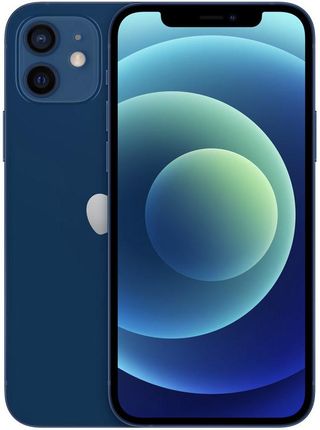iPhone 8 review: The upgrade many people will be looking for

April 11, 2018: (PRODUCT)RED iPhone 8 and iPhone 8 Plus now available in stores and for immediate delivery.
Just like last year, Apple has released a new iPhone color for the spring — and it's (PRODUCT)RED. iPhone 8 and iPhone 8 Plus begin shipping in Product RED on Friday, April 13, in Australia, Canada, China, France, Germany, Hong Kong, Japan, New Zealand, Singapore, South Korea, the UK and US on Friday, April 13. Brazil, Denmark, Ireland, Italy, Malaysia, Mexico, Netherlands, Norway, Russia, Saudi Arabia, Spain, Sweden, Switzerland, Taiwan, Thailand, UAE. Other regions to follow.
Greg Joswiak, Apple's vice president of Product Marketing:
This special edition (PRODUCT)RED iPhone features a stunning red and black color combination and also offers customers the opportunity to make an impact in fighting the spread of HIV and AIDS. iPhone 8 and iPhone 8 Plus improve on everything we love about iPhone, including Retina HD displays that are more beautiful than ever, the most powerful and smartest chip ever in a smartphone with the A11 Bionic and more advanced cameras for unbelievable photos and videos. We are proud to support (RED) with this bold new iPhone and hope customers think it is as special as we do.
Deborah Dugan, (RED)'s CEO:
Today's announcement is further evidence of Apple's leadership in and commitment to the AIDS fight since the beginning of (RED) in 2006. The more than $160 million Apple has donated in the last 11 years today equates to more than 800 million days of lifesaving ARV medication that prevents the transmission of HIV from mothers to their babies. We're honored that Apple has dedicated its resources to our purpose, and can't wait to see customers bring our mission to life through the purchase of iPhone 8 and iPhone 8 Plus (PRODUCT)RED Special Edition.
The most notable difference this year is the inclusion of a black rather than white front plate. Not only will that appeal to those who prefer the red on black look, but it differentiates this year's (PRODUCT)RED iPhone from last year's, which is important.






People are both easily bored and hate change. We want something familiar but different. And just how familiar and how different varies from person to person and situation to situation.
Do you prefer The Force Awakens because it's the next iteration of what you know and love, or do you prefer Rogue One, because it mixes some of those elements up in interesting new ways?
Master your iPhone in minutes
iMore offers spot-on advice and guidance from our team of experts, with decades of Apple device experience to lean on. Learn more with iMore!
This year, Apple is asking the same question. Would you prefer iPhone 8, a better version of what you're already familiar with, starting at $699. Or are you ready for iPhone X, a more radical departure, starting at $999.
Both phones have many of the same core feature enhancements, including camera sensors, processors, and inductive charging. It's how you can tell Apple is offering both as legitimate options. It makes choosing between — and reviewing — them a challenge.
iPhone 8: In brief
For people who want:
- 4.7 and 5.5-inch options
- The most powerful phone/pocket computer on the market
- Significantly improved cameras
- Wireless charging
- Fingerprint biometrics
- Gold color option
Not for people who want:
- Deleted bezels
- Deleted Home button
- OIS on both wide and telephoto cameras
- New design
- Face ID biometrics
- Low pricing
If you want an all-new iPhone experience, iPhone X will be here in a month or so. If you love everything about your existing iPhone, including the Home button and Touch ID, and you just want it to be faster, with better cameras, and convenience features like inductive charging, iPhone 8 is here for you right now.
iPhone 8: Second opinion
I review iPhones from the point-of-view of an iPhone owner and someone immersed in the Apple ecosystem. Increasingly, though, iPhones are being bought by people switching from Android.
In order to provide a second opinion, and from a perspective very different from mine, we collaborated with ace YouTube reviewer Michael Fisher to get his take and an early look at how iPhone 8 compares to the competition.
iPhone 8 Unboxing
Included in the iPhone 8 box is the phone itself, information pamphlets and Apple stickers, Lightning EarPods, 3.5mm to Lightning adapter, a Lightning to USB cable, and an AC adapter.
Given that Apple has sold MacBooks and MacBooks Pro with only USB-C ports going on three years now, the lack of a USB-C cable with USB-A adapter is beyond ridiculous.
Likewise, in an era of fast charging, the lack of an AC adapter that can charge fast is disheartening.
iPhone 8: Name and design
About the laziest way I could start this review is with some crack about how Apple should have gone with "iPhone 7s" for the name. (Almost as lazy and predictable as saying Apple should have gone with "iPhone 6sss".)

I think Apple originally went with the "number" / "number + s" convention to try and market around the generations where the more substantive changes were internal rather than external.
We tend to be superficial and so the excitement over new optics, silicon, or other enhancements can pale by comparison to new visual design. iPhone 3GS and iPhone 4s were seen as more acceptable, especially in a market where most people upgraded only every two years or so. (It also kept Apple from running out of single-digit numbers in 2015...)
Then, Apple learned to hack our superficiality by adding color variations to the s-years. Turns out, we'll grouse about the look staying the same but we'll leap at the chance to get it in gold.
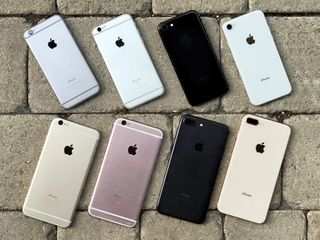
Now, the market has matured. I think we've matured as well. We've realized that both "number" and "number + s" generations can introduce significant improvements, including virtual assistants, display sizes, biometric identity scanners, pressure sensors, fusion camera systems, and more.
iPhone 7 exemplified that. Apple's industrial design team could have made it triangular or donut-shaped if they'd really wanted to stick with the old naming pattern. Instead, they iterated on materials while leaving the shape almost the same.
Same with iPhone 8. Instead of sticking to pattern for pattern's sake, Apple seems to believe the all-new industrial design combined with the new internals are enough to warrant a full number increase for the name. (And they're willing to use up one of the precious few single-digit versions left — or intent on burning through them as fast as possible.)
What all-new industrial design, since iPhone 8 looks so much like iPhones 6 through 7?
The all-new industrial design that rebuilt iPhone 8 down to an atomic level. That Apple once again made iPhone 8 fit into exactly the same shape as the last few iPhones before it shows, like last year, just how dedicated the team is to that shape. Like switching from vanilla to chocolate cake but using the same mold.
It's as if Apple's industrial designers resolutely believe they've achieved the Platonic ideal for a device of this size with a Home button and Touch ID sensor — Form iPhone — and they're not going to change it just to be trendy or simply for change's sake.
It might be admirable. It might just be stubborn. It might keep them customers adverse to change and cost them customers who find it boring. Either way, it's clear that Apple's hardware team took the new glass and new aluminum and went out of their way to fit it all into precisely the same shape, even knowing the just-as-same-old "bored now" comments that would follow. (Perhaps because this year, they knew they'd have an answer for those people with iPhone X.)
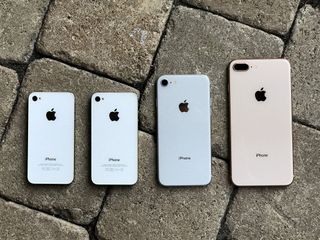
The new glass in iPhone 8 is the result of a close partnership and collaboration between Apple and Corning. One that goes down to the engineering level. It allowed both companies to collaborate on an ion-exchange process that goes 50% deeper than before, and support it with an internal, laser-welded, steel and copper substructure.
Thanks to Apple and Corning's partnership, iPhone 8 (and iPhone X) also has exclusive access to this ultra-durable glass. At least for now.
It's still glass, though — once again on both sides, like iPhone 4 and iPhone 4s before it. (Though now, serenely, absolutely free of FCC indicia.) And glass breaks, just like ceramics shatter and metal bends. (Physics, it turns out, is a jerk.) But at a materials level, it feels like Apple is doing everything possible to make its new glass the most resilient possible, and to mitigate against the smaller scratches and fractures that can lead to cracks and breaks over time.
And that's good, because glass is slippery. iPhone 8 isn't as bad as Nexus 4, which if you put it in the middle of a flat table would eventually find its way to the floor, but it's slipperier than any iPhone since iPhone 4s. So, if you typically put your iPhone on armrests, sofas, or other non-flat surfaces, stop doing that or get a case with a higher coefficient of friction. At least until Apple figures out how to make its new glass less slippery.
Over the course of the last week, I've seen both iPhone 8 and iPhone 8 Plus survive some pretty nasty falls, and I've seen one hit stone tile and crack across the Home button. (The internet is full of drop tests already as well, because internet.)
I'm sure I could keep dropping iPhone 8 until I shatter them on both sides, just like I could keep crossing the street until I got hit by a car. I'm not terribly interested in discovering either of those failure points right now. I do have a history of dropped phones, which is why I have Apple Care and recommend it to anyone who asks. It's a relatively small investment, and an excellent value for a device that has literally become the cyborg extension to my life.
The glass — and iPhone 8 — comes in three new finishes marketed under three not-so-new names: space gray, silver, and gold.
Apple says there's a seven-layer color process behind the finishes that allows for both opacity and depth. It reminds me of how Jony Ive and team got so much depth in the original iPod finishes. The silver and space gray end up looking pearlescent white and slate, the gold, opalescent taupe. And because they're glass, the antenna lines are all gone.
The new aluminum is 7000 series and "aerospace" grade. It's silver, gray, and coppery/rose-ish gold on the three finishes respectively. To prevent attenuation between the different antenna systems, there are still breaks in the bands. Those are color-matched to the glass.
They're also microscopically sealed to protect against liquid and particle ingress. That means, like iPhone 7, iPhone 8 is IP67 water and dust resistant under IEC standard 60529. In my quick splash and immersion tests, they can take the same kind of dipping and keep on ticking. (Sorry.)
That's despite having a speaker system that Apple says is 25% louder and with deeper bass than last year's. In my testing it's absolutely lounder and hass more bass, but I'm not sure it's clearer. I don't have golden ears, nor am I a fan of booming systems, so I'll hit up some of my more musical colleagues to get a better sense of the speaker quality. Calls sound fine, not too Mickey, not too Vader.
Practically speaking, I wasn't sure how the loss of the previous aluminum chassis would affect the rigidity needed for 3D Touch, especially on iPhone 8 Plus. Thanks to the combination of new glass and new aluminum, though, I haven't had any problems. The best compliment I can give is that I haven't even noticed the difference, and that's a pretty impressive feat of engineering.
Put that in your iPhone 7s bubble pipe and pop it.
iPhone 8 True Tone Display
Last year, Apple brought DCI-P3 wide color gamut to iPhone with its richer reds, deeper magentas, and more vibrant greens. The results were dazzling and there's simply no going back. The next best step would be HDR (high dynamic range), which allows for even more detail in highlights and shadows.
LCD, which is the technology Apple has used for all iPhones to date, has many great characteristics, but the brightness and contrast ratio needed to really showcase HDR isn't one of them. We still have the building blocks in iPhone 8, including hardware-level support for 10-bit HEVC and a brightness level that goes up to 625 nits. So, like the latest iPads Pro, iPhone 8 will do the best it can with HDR. But, it's really the upcoming iPhone X, with a 1:1,000,000 contrast ratio OLED display, that will put real, end-to-end HDR in our hands and pockets for the first time.
What we are getting this year is True Tone. It debuted on the 9.7-inch iPad Pro over a year ago but this marks the first time it's been available on iPhone. The technology is cool: A four-channel ambient light sensor measures the color temperature of your environment and then adjusts the display so that white looks white. Not warm, yellow, incandescent white. Not cool, blue, fluorescent white. White. Paperwhite.
It's different from Night Mode, which subtly shifts the display towards the warmer, more yellow temperature as the day wears down in an effort to mitigate against the sleep-damaging effects of staring at screens all evening.
True Tone works 24/7 to make sure when you read an eBook, look at a photo, browse the web, watch a movie, or do anything at all on iPhone 8, the color is accurate. And not just accurate to how Apple individually calibrates it down to the sub-pixel level at the factory. Accurate to how you're looking at it every moment, from sunlight to candlelight, halogen to Hue. Carrying your iPhone around becomes like carrying a tiny, printed book or magazine around. It just looks right.
Like DCI-P3 and HDR, once you see, you want it everywhere and it's incredibly hard to go back. Like whiplash of the eyes hard.
iPhone 8 Wireless Charging
Once upon a time, Apple said it was unclear how much convenience wireless charging actually added. Same with NFC payments. Steve Jobs, famously, said no one wanted to watch video on an iPod. Now we have the TV app in our Home screens, Apple Pay in our hands and, with iPhone8, Qi standard inductive charging from any nearby pad.
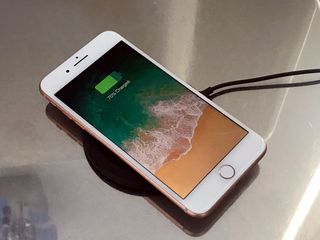
I'm not a huge fan of inductive charging. I've had it on phones since my Palm Pre in 2009 and on one Android phone or another over the years.
It does offer convenience. Rather than having to reach for and find the end of a Lightning cable, and fumble with getting it into the Lightning port, you can simply drop your iPhone 8 down on the pad and it'll start charging. Mostly.
My experience is that every once and awhile, it'll miss the sweet spot or get jostled off of it at some point and simply not charge. The same is true for iPhone 8.
It's also not as fast or as efficient as wired charging. The current Qi implementation feels about as fast as using the tiny square brick that comes with iPhone 8. Meanwhile, wired charging with an iPad brick is significantly faster and, and getting faster still with an iPad USB-C brick — up to 50% in 30 minutes.
Still, setting up a Qi pad on the table next to your bed or the desk where you work is nice. When you're tired or busy — as long as you make sure the connection takes — it's super nice.
Two things have to happen for it to go beyond super nice, though. At least for me.
- The presence of Qi pads in restaurants, coffee shops, hotels, and vehicles has to rapidly increase.
- Contact charging needs to give way to short distance charging.
Apple pushing Qi could and should help with the first one. There's nothing like flooding a market with tens and eventually hundreds of millions of implementations to get supporting industries to take notice. When every Starbucks, McDonald's, Aloft, and Uber has one, the value will be astronomically higher.
Apple super-setting Qi, the way the company is already doing with it's AirPower pad, coming next year, could and hopefully will result in the technology improving faster. As long as the pad/pod is on the table or desk, I should be able to drop my iPhone anywhere within a few inches and have it just charge, sweet spot be damned.
AirPower will charge either an iPhone, Apple Watch Series 3, and AirPods (with an upcoming and sold-separately new charging case), or up to two iPhones and a Watch or AirPods. It's already an example of Apple super-setting Q, and hopefully just the first.
iPhone 8 Camera System
As petty as the "iPhone 7s" naming quibbles are, a real argument could be made for calling this device iCamera 8. Neither name accurately reflects the full range of capabilities we now have in our hands and pockets but its clear the camera is one of the things Apple puts extreme effort into year after year, and one of the primary reasons people upgrade their iPhones year after year.

The quality of call you place to your loved ones is certainly important. But the photos and videos you take of them — the memories in time and space you capture — are absolutely priceless.
Having the "world's most popular camera" comes with enormous responsibility. And having the "best camera you have with you" comes with enormous pressure to make it the best camera you have period.
With iPhone 8, Apple takes another step in that direction. The rear-mounted camera system remains single lens (wide-angle) on iPhone 8 and dual lens (wide-angle + "telephoto") on iPhone 8 Plus, and 12 megapixels. The wide angle likewise remains f/1.8 and the tele, f/2.8.
What's new is the sensor. The pixels are "deeper", which further reduces cross-talk and improves accuracy. It's also larger and faster. That means it will pull in more light and let you capture more immediately, so you get the moment you want, not some moment close-ish thereafter.
There's also a new color filter, which is a rarity these days in the camera world. Apple isn't saying much about it yet, but the company is promising it provides better, truer colors across a wider dynamic range, and with less noise.
Like iPhone 7, the wide angle lens has optical image stabilization (OIS). Also like iPhone 7 Plus, the telephoto lens does not. That means low-light won't be as tack-sharp as absolutely possible under some circumstances. If you want OIS on both, you'll have to wait for iPhone X.
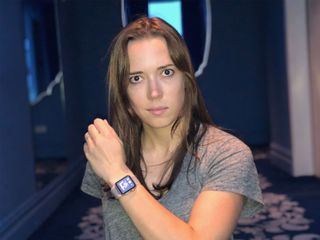
You do get the new quad-LED flash, still named True Tone, which is confusing now since the new display technology has been given the same name. The big deal with the new version is slow sync.
Typically, when you take flash photos at night, you get lit up subjects and blacked out backgrounds. Slow sync combines a slow shutter speed with a short probe pulse that better exposes both the subject and the background.
Slow sync is exactly the type of feature I never realized I was missing on my iPhone until I shot with iPhone 8. Then I wished I could go back in time a retake every extreme low-light photo I've ever taken. So my memories would look like they existed where they really were and not in some cave.
Apple's new ISP (image signal processor), built into the company's A11 Bionic system-on-a-chip (see below), does all the usual auto-white balance, auto-focus, and auto-exposure, but also analyzes the scene for lighting, people, motion, and other elements and continuously optimizes for capture. That way, when you hit the shutter, it's not just ludicrously fast, it's ludicrously good.
It's also speedy enough that HDR is simply left on automatic by default. You can toggle it off if you really want to but you shouldn't. The ISP will read the scene and, if it thinks HDR would be a benefit, it'll shoot in HDR about as fast as it would without.
It'll also detect things like sky, fabric, and other textures. That way, even after it does its fancy new hardware accelerated multi-band noise reduction, it can go in and make sure texture is not only maintained but not interfered with by compression. The result is skies that look deep and clear, weaves where you can almost see every strand and thread, and gravel that you can almost hear the crunch.

It also detects things like concerts, which are traditionally hard to resolve, and then figure out the background while focusing on the action. Snow and ice too, so rather than massive blowouts you get detail in the frozen landscapes without losing your subjects to shadow.
It's all part of Apple's continued goal to give everyone an easy-to-use camera and Camera app that's ready the moment you pull it from your pocket and, when you hit the shutter, captures you the absolute best, most natural-looking photo, in the widest range of situations and circumstances as possible. And, year after year, iteration by iteration, pixel by pixel, Apple is delivering.
When comparing to iPhone 7 it was small differences that I noticed. Leaves in the background or wooden planks on the floor that were clear and distinct rather than smeared together. Even in low light.
Those kinds of details might not matter to you but they make the scene more real and more powerful, and that matters to me and, I think, to everyone who cares about imaging quality.
Here's what a gentleman at Apple Store 5th Ave. told me on launch day about why he was picking up an iPhone 8 Plus:
"iPhone is my only camera. I use it to take photos of my babies. I can never go back in time and get better photos of the past. But I can get better photos starting today. Of course, I'm upgrading."
Of course, the cost of all this silicon-enhanced photography is that it sometimes fails you. It's not often — usually when you're combining several factors like extreme low-light and motion detection, you can hit the limits of the system. But those are often the shots you'd never have gotten before. Maybe never even tried. Now the expectations have changed and you're willing to try almost everything.
That brings me to iPhone 8 Plus. Optical zoom and Portrait Mode — now out of beta — benefit from the better optics. Portrait mode also gets huge boost from A11 Bionic. Where, previously, it felt like the effect was pegging the A10 Fusion on my iPhone 7 Plus, on iPhone 8 Plus it feels like it still has tons of headroom. So much so, that Apple is adding Portrait Lighting — now in beta.

Where Portrait Mode tries to solve for "people like Bokeh in their photos but don't want to carry around big, fancy lenses", Portrait Lighting tries to solve for "people like dramatic lighting in their photos but don't want to carry around floods and reflectors".
Portrait Lighting is only available on iPhone 8 Plus and iPhone X. Apple could certainly run the software on iPhone 7 Plus, but the experience isn't what the company wants. (Much like video was exclusive to iPhone 3GS when it launched, and indie efforts to port it down to iPhone 3G resulted in a frustrating 15 fps capture rate.)
Even on iPhone 8 Plus, Portrait Lighting is still a work in progress. Under ideal conditions, you get a Studio Light that illuminates your subject's face, a Contour Light that tunes up the shadows and highlights, a Stage Light that loses the background to inky darkness, and a Stage Mono look that does the same but in black and white.
Under less than ideal conditions, you get hilarious failure replete with miss-detected edges and wackily illuminated faces.
But here's the thing: It costs you nothing to try. Apple supports the HEIF (high-efficiency image file) format not only in iOS 11 but at the hardware level on A11 Bionic. With HEIF, the depth map is stored separately in the same container, so you can toggle it on and off at any time, just like a non-destructive filter effect or one of the new Live Photo modes like Bounce or Loop. That means you're free to experiment with zero risk. If it works, great. If not, tap it off and you have the original, unmodified image. It takes all the stress away and just lets you play. And that's where real creativity and inspiration comes from.

Also, Portrait Mode has made incredible improvements over the span of the last year, though, and I expect Portrait Lighting to be similar.
Most of all I'm wondering what trick Apple's computational photography team can take from the pro photographers bag next? Portrait Backgrounds?
Where Apple is clearly competing with the best in prosumer pocket cameras now there's on area where the company feels its pulled far ahead: video.
For iPhone 8, the architecture from capture to encoding has throughput enough to record 4K at 60 FPS. And it can maintain that capture rate for extended periods of time without breaking a sweat. Seriously, roaming on the cellular network warmed the glass up more.
It can also do 1080p Slo-Mo at 240 FPS. Like the 4K at 60 FPS, these simply aren't features you expect to see on prosumer video cameras, much less "phones". Yet here they are and, in our quick tests, they hold up remarkably well.
Apple's using HEVC (high-efficiency video codec, the horrible acronym for H.265) for the encoding now, which has more overhead but results in files roughly half the size of H.264. Again, it's supported in both iOS 11 and at the hardware level on A11 Bionic, which seems to just chomp through it.
What's more, the ISP is doing predictive analysis on the video at a granularity of 2 million tiles per frame for the same kind of elements as is does for photos, including skies, textures, and motion, and then optimizing the compression to preserve as much detail as possible.
My colleagues, Serenity Caldwell, Derek Kessler, and I are in the midst of our usual in-depth photo and video tests, so expect much more on all of this over the next few days and weeks.
The last but absolutely not least thing to note about the iPhone 8 camera system is that it's been enhanced for augmented reality (AR). Apple's gone all-in on its ARKit framework and, to ensure the best experience possible for ARKit-based apps, the company has calibrated the camera system and updated both the gyroscope and accelerometer specifically for AR.
Since ARKit apps started hitting the store at the same time as I started using iPhone 8, I haven't been able to compare extensively with how they perform on iPhone 7, but they're impressive on both.
For a while, Apple was making previously inert input devices smart: The mic got Siri so it could understand what we said; the Home button got Touch ID so it could tell who we are. The camera has had face detection for a while and will soon have Face ID. But with ARKit it starts to understand that world around us, interpret it, and bring it to strange new life.
Sample furniture as if it's sitting in your very own living room. Raid a castle floating over your coffee table. Land a starfighter in your backyard. See a Sudoku scanned and solved right before your eyes. Punch a hole in the world and step right on through.
It's sci-fi magic. Even if you have to hold your iPhone 8 up in front of your eyes to see any of it. At least for now.
iPhone 8 A11 Bionic
Last year Apple switched from using simple, raw numbers to differentiate its silicon generations to numbers backed up by brand names. So, iPhone 7 launched with A10 Fusion, a reference to it's dual, paired performance.EFFICIENCY cores. Now, iPhone 8 launches with A11 Bionic. It doesn't have human.MACHINE cores so much as it has a Neural Engine block and Bionic — as in the Six Million Dollar Man and Woman (ask your parents) — is just a cool sounding way to market that.

It's also a cool sounding system-on-a-chip. Instead of four cores it has six, two high-performance and four high-efficiency. The high-performance cores are up to 25 percent faster than A10 and the high-efficiency cores are up to 70 percent faster. Instead of being paired, all six cores can be addressed at the same time for some impressively massive parallelism.
It results in A11 Bionic benchmarking faster than some laptops, including MacBooks Pro. In a system that fits in your pocket. Without a fan.
Part of the silicon team's secret sauce here is their performance controller. They've only been singling it out for a couple years, but it's essentially the dispatcher that sits between tasks and chips and makes sure everything is done as fast as possible while consuming as little power as possible.
Also new this year is Apple's first, fully custom, three core graphics processor and the aforementioned Neural Engine block. The graphics, for example, lets iPhone 8 render highly detailed, highly textured models to put into the CPU-tracked 3D space of ARKit. The Neural Engine block accelerates Core ML, the machine learning framework that's increasingly touching so much of Apple's experiences.
What's fascinating is that, when you hear people talk about it, it sounds more like training a pet than coding a computer. Which is amazing. And terrifying. (Though Apple, as always, is keeping everything local to the device so it's private and secure. And, in an AI uprising, I can take an iPhone. I think…)
Equally interesting is that, while competitors were screaming AI from every stage and analysts were worrying that Apple had missed it entirely, three years ago the silicon team was already working towards it for A11 Bionic, just like software teams were already doing computer vision and the hardware teams were already using predictive patterns to optimize battery life.
Speaking of which, I've only been using iPhone 8 and iPhone 8 Plus for a few days, and alongside other phones for relative testing.
I have played some Pokémon Go on iPhone 8 Plus, which is about the worst thing you can do to a battery, and it's held up about the same as my iPhone 7 Plus did. That is to say, it drains, and fast, but at around the same rate.
That's in line with Apple's estimates and long-standing practice of keeping battery life the same while using improvements in efficiency to offer more features or lighter, easier to handle devices.
While I get that lightness is key to usability — if you can't hold up your phone for long periods of time to read a book, play a game or watch a movie, that extra battery life doesn't help you much — we are entering an era where I think Apple has to work for a better balance.
It's not just Pokémon Go, either. It's Snapchat and Instagram and now, AR. Modern usage isn't just checking mail or surfing the web every few minutes. It's firing the display, GPS, cellular data, and hitting the SoC, hard, for long and sustained periods of time.
Yes, batteries are insulators, which increase heat, and they're not RF transparent, which makes radios a challenge, and you can't just pipe more in like it was frosting. But increasing battery life to better meet the demands of modern apps is something Apple's going to need to address.
(It also seems like Apple is doing something strange with GPS on iPhone 8. In low-power mode it no longer updates as continuously as it did on iPhone 7. Even off low power mode, it'll sometimes jump around when waking from sleep. I'm looking into this more and will update with any answers I get or figure out.)
iPhone X is teasing an extra couple of hours of battery life, perhaps due to its new technologies like OLED. If that ends up being the case, it's a good step forward.
Overall, A11 Bionic shows that, even though no one else in the industry is doing silicon like Apple. Not even close. And Apple is happy to keep that team and these chipsets not just racing ahead, but accelerating.
If you're a fan of computers in general, you can't help but want iPhone. A-series powered devices continue to be the most exciting silicon in consumer tech.
iPhone 8 Accessories and Apps
iPhone 8 and iPhone 8 Plus are physically the same design and dimensions as iPhone 7 and iPhone 7 Plus. While they're broadly the same shape as iPhone 6s and iPhone 6s Plus, and iPhone 6 and iPhone 6 Plus, differences in the camera size and positioning, and the absence of a 3.5 mm headphone jack can cause some issues with older accessories. Measure twice, fit once.
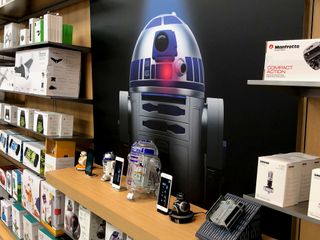
Needless to say, there are a ton of accessories available already, from cases to screen protectors, charging pads to car mounts, toys to drones. We regularly update lists of our favorites:
- Best iPhone 8 accessories
- Best iPhone 8 cases
- Best wireless Q1 charging pads for iPhone 8
- Best screen protectors for iPhone 8
- Best car mounts for iPhone 8
Since iPhone 8 and iPhone 8 plus run iOS 11, they're compatible with all the millions of apps in the newly redesigned iPhone App Store. That includes all the apps from Google, Microsoft, Facebook and Instagram, Twitter and all the games you could imagine. If you're coming from either Android or Windows Phone, you'll feel right at home.
There's also a whole slew of just-launched augmented reality (AR) apps as well.
iPhone 8 can run AR with processor headroom to spare, and the cameras have been calibrated to provide the best AR experience possible. Many of them are cool. Others open up new worlds and blow your freaking mind.

Every iPhone 8 and iPhone 8 Plus ships with iOS 11, Apple's latest-generation multitouch operating system. It will even let you set up your iPhone 8 simply by bringing it close to your old iPhone.
iPhone 8 Pricing and Availability
iPhone 8 and iPhone 8 Plus are available now starting at $699 and $799 for the 64 GB versions, or $849 and $949 for the 256 GB versions. (Apple is no longer offering versions with less than 64 GB, or a version with 128 GB.)
Still, that's $50 more than the starting price of any previous iPhone flagships and, even with the storage increase, that sucks.
Apple hasn't said specifically, but with iPad Pro prices rising as well, it's likely the same cause — the soaring cost of memory chips. It's unclear how long the shortages and related increases in component prices will last, but hopefully, we'll see a corresponding price drop if and when supply and pricing stabilize again.
With your iPhone 8 comes Apple Stores and AppleCare.
Apple Stores are in the midst of a serious upgrade. Not only are they improving the traditional Genius bars to provide for better, hands-on technical support, they've added Creative Pros to help you with using the features on your phones, and Apple Today as a hub for education and arts.
Competitors still haven't caught up to the level of service available in the old Apple Stores, much less the new ones. And there's just no way to even begin to compare the value of iPhone to other phones without including Apple Stores — and Apple Care.
With Apple Care, you're covered against the usual issues for a year. With Apple Care+, you're covered for two years, including up to two $29 screen and $99 water/other repairs/replacements.
If, like me, you're not always as careful with your technology as you should be, then you, like me, might extract significant value from AppleCare+ over the course of a couple years.
iPhone 8 Conclusion
It's not hard to justify iPhone 8. Even in a world where Apple could have gone all in on iPhone X, it would have left some customers behind. That's easy to do when the base is in the tens of millions. It's much harder when it's in the hundreds of millions.
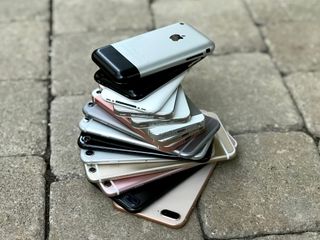
We saw that first hand when iPhone 6 and iPhone 6 Plus launched. Apple didn't hedge with an update of the existing design and that upset some customers. Customers who stayed upset until iPhone SE was introduced over a year later. Maybe, just maybe, Apple has learned a thing or two since then.
Unless you're part of the iPhone Upgrade Program or a similar carrier program, which provide year-over-year upgrades as part of the monthly payment plans, most people simply don't upgrade every year. They upgrade every couple or few years. iPhone 8 will be the first upgrade for people coming from iPhone 6 or iPhone 6s, maybe even from iPhone 5, iPhone 5c, or iPhone 5s. Compared to those phones, especially the older ones, either iPhone 8 or iPhone X will be tremendous upgrades.
If you want an all-new experience, you'll be able to get iPhone X in November. If you love everything about your existing experience, including the Home button and Touch ID, and you just want it to be faster, with better cameras and conveniences like inductive charging, you can get iPhone 8 today.

Rene Ritchie is one of the most respected Apple analysts in the business, reaching a combined audience of over 40 million readers a month. His YouTube channel, Vector, has over 90 thousand subscribers and 14 million views and his podcasts, including Debug, have been downloaded over 20 million times. He also regularly co-hosts MacBreak Weekly for the TWiT network and co-hosted CES Live! and Talk Mobile. Based in Montreal, Rene is a former director of product marketing, web developer, and graphic designer. He's authored several books and appeared on numerous television and radio segments to discuss Apple and the technology industry. When not working, he likes to cook, grapple, and spend time with his friends and family.

Apple's thirst for sports could add live NBA games to MLS and MLB as streaming deal talks get ready for tip-off

iPad Air 6 in larger size ‘leaked’ by over-enthusiastic case manufacturer — ESR preps for the 12.9-inch model and new iPad Pro, ahead of rumored May launch

Apple's huge AI iPhone upgrade will be entirely on-device to start with — 'Full details' expected at WWDC 2024 with iOS 18 ahead of iPhone 16
Most Popular





